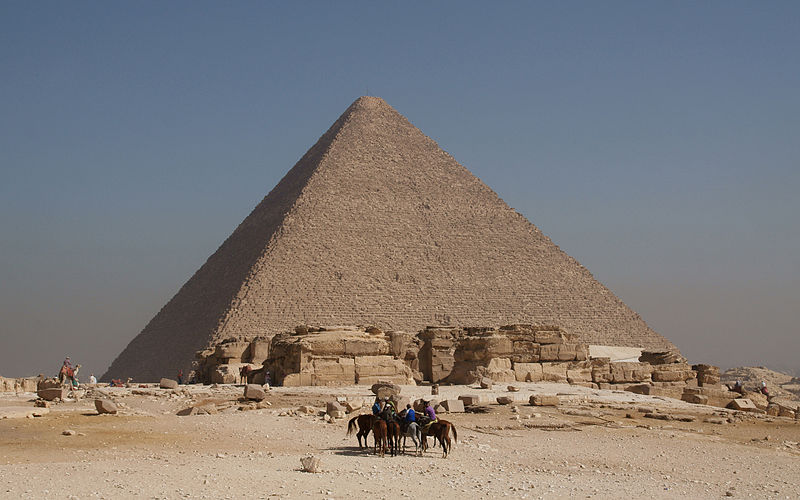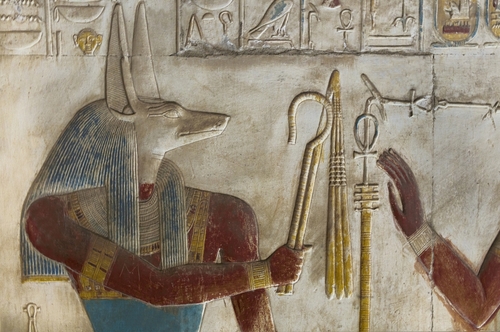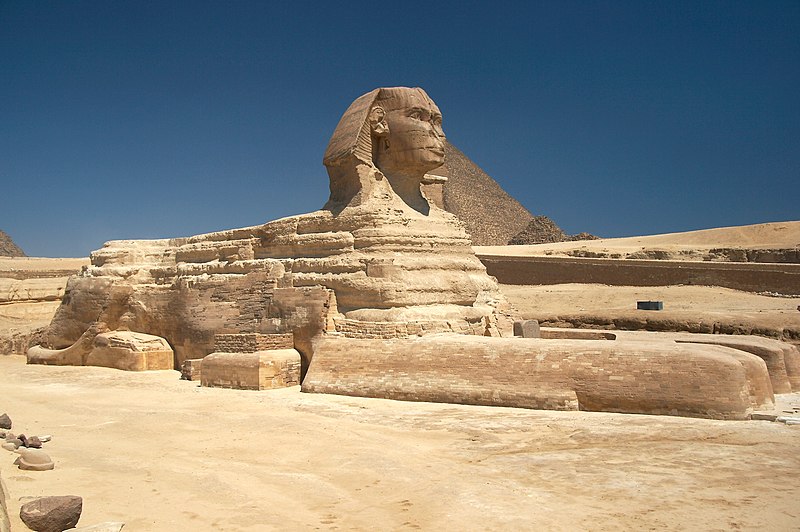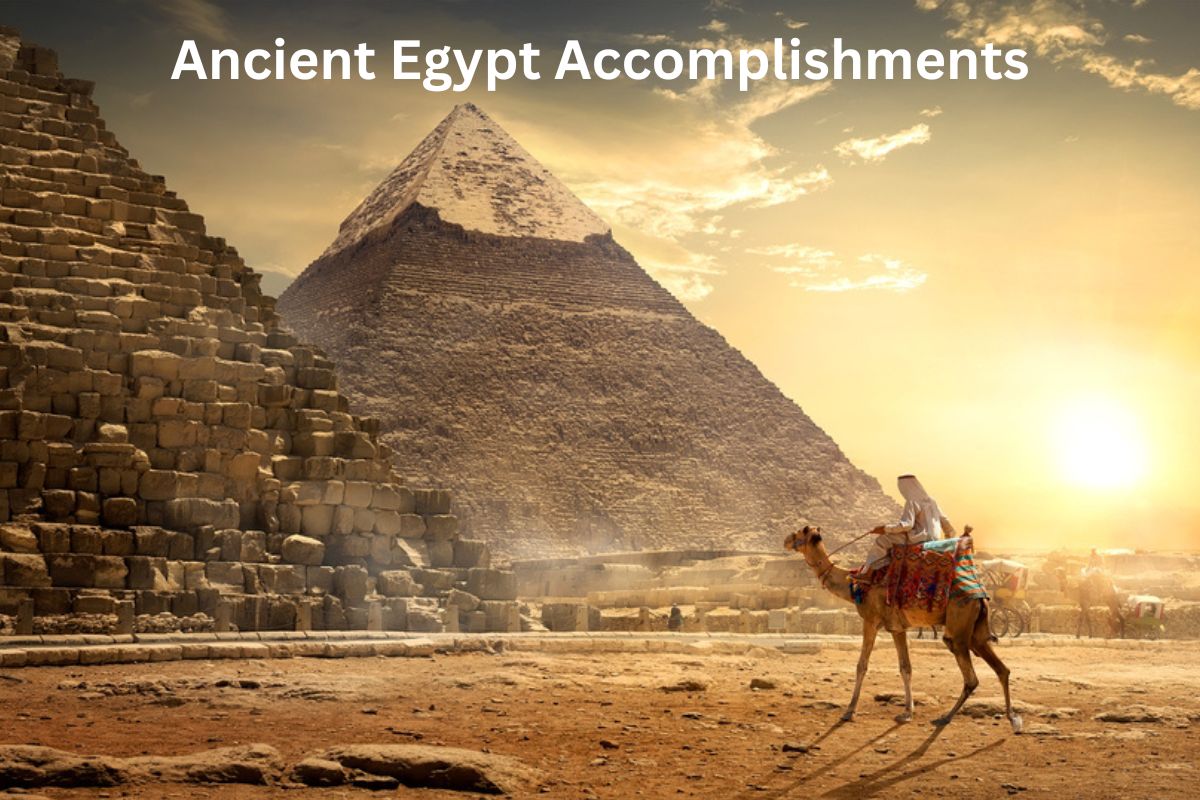Ancient Egypt was a civilization that thrived for over 3,000 years along the Nile River in northeastern Africa. It is known for its rich culture, monumental architecture, complex religious beliefs, and advancements in various fields.
The society was hierarchically structured, with pharaohs as political and divine leaders. Religion played a central role, and the Egyptians made contributions in writing, mathematics, astronomy, medicine, engineering, and agriculture.
Their architecture, including pyramids and temples, is renowned. Ancient Egypt’s history and cultural achievements continue to captivate the world.
Accomplishments of Ancient Egypt
1. Construction of pyramids
Ancient Egyptians built remarkable pyramids as tombs for their pharaohs. These pyramids, such as the Great Pyramid of Giza, were monumental structures characterized by their massive scale, precise construction techniques, and architectural sophistication.

They served as grand burial sites for the pharaohs, who were believed to transition to the afterlife. The construction of pyramids required immense manpower, engineering knowledge, and organizational skills.
Also Read: Top History Podcasts
The Egyptians employed innovative techniques, such as the use of ramps and pulleys, to move and position the massive stone blocks. The pyramids are a testament to the ancient Egyptians’ dedication, craftsmanship, and mastery of engineering.
2. Development of hieroglyphic writing
Ancient Egypt is known for the development of hieroglyphic writing, one of the earliest writing systems in human history. Hieroglyphics were a complex system of pictorial symbols that represented objects, concepts, and sounds.
This writing system allowed the Egyptians to record and communicate various aspects of their society, including historical events, religious beliefs, and administrative matters. Hieroglyphic inscriptions can be found on temple walls, tombs, and papyrus scrolls.
The decipherment of hieroglyphics in the early 19th century provided invaluable insights into the culture, history, and language of Ancient Egypt.

3. Advancements in medicine and surgery
Ancient Egyptians made significant advancements in medical knowledge and practice. They developed a sophisticated understanding of anatomy, disease, and treatments.
Egyptian physicians had a holistic approach to medicine, combining magical rituals, herbal remedies, and practical medical techniques. They treated various ailments, including injuries, infections, and diseases, and developed techniques for setting broken bones, suturing wounds, and performing basic surgeries.
The Egyptians also practiced preventive medicine and hygiene, recognizing the importance of cleanliness in maintaining health. Their medical knowledge and practices were influential and laid the foundation for later medical advancements in civilizations around the world.
4. Contributions to mathematics and geometry
Ancient Egyptians made notable contributions to mathematics and geometry. They developed a sophisticated system of mathematics that included arithmetic, algebra, and geometry.
Egyptian mathematics utilized a decimal system and fractions. They had practical knowledge of measurement, including calculating areas and volumes. The Egyptians used their mathematical expertise in various fields, such as architecture, land surveying, and trade.
They also applied geometry to construct precise and symmetrical structures, including temples and tombs. Their mathematical advancements laid the foundation for later mathematical developments in civilizations across the globe.
5. Study of astronomy and development of a calendar
Ancient Egyptians were keen observers of the celestial bodies and made significant contributions to the field of astronomy.
They studied the stars, planets, and the movements of the sun and moon. Based on their observations, they developed a calendar system to track time and organize their religious festivals and agricultural activities.
The Egyptian calendar was a solar calendar divided into 12 months of 30 days each, with an additional five or six intercalary days at the end of the year. This calendar was remarkably accurate for its time and provided a basis for other civilizations’ calendars.

6. Engineering feats and irrigation systems
The Egyptians were skilled engineers and accomplished impressive feats of construction. They built monumental structures, including temples, obelisks, and fortifications, using advanced architectural techniques.
The Egyptians also excelled in hydraulic engineering, particularly in developing sophisticated irrigation systems to harness the annual flooding of the Nile River. They constructed an intricate network of canals and basins to distribute water to farmlands, ensuring agricultural productivity and the sustenance of their civilization.
The mastery of engineering and irrigation systems by the ancient Egyptians played a crucial role in their ability to thrive in an otherwise arid environment.
7. Skill in shipbuilding and navigation
Ancient Egyptians were skilled shipbuilders and navigators, allowing them to engage in trade and exploration. They constructed different types of ships, including river vessels and seagoing boats, using techniques such as mortise and tenon joints, rope lashings, and wooden pegs.
These ships enabled them to navigate the Nile River for trade and transportation and venture into the Mediterranean Sea. The Egyptians had a good understanding of navigation, utilizing celestial observations, landmarks, and navigational tools like the astrolabe and the sun compass.
Their maritime skills facilitated cultural exchanges, trade with neighboring regions, and expeditions to distant lands.
8. Artistic and architectural achievements
Ancient Egypt is renowned for its exceptional artistic and architectural achievements. Egyptian art was characterized by its grandeur, symbolism, and focus on permanence. They created elaborate statues, intricate wall paintings, and relief carvings that depicted gods, pharaohs, and daily life scenes.
These artistic works adorned temples, tombs, and other sacred structures. Egyptian architecture displayed monumental structures such as temples, obelisks, and tombs, showcasing their mastery of engineering and aesthetics.
The grandeur of their art and architecture served religious, political, and funerary purposes, leaving an indelible mark on the history of art.
9. Innovation in textile production
Ancient Egyptians were renowned for their advanced textile production techniques. They developed innovative methods of spinning, weaving, and dyeing fabrics. Egyptian craftsmen were particularly skilled in producing linen, which was highly regarded for its quality and fine texture.
They used looms to weave linen garments for both practical and symbolic purposes. Egyptian textiles were in high demand and were exported to various regions, contributing to their economic prosperity and cultural influence.
10. Advancements in agriculture and irrigation techniques
Agriculture was a vital aspect of Ancient Egyptian society, and they made significant advancements in this field. The Egyptians developed innovative agricultural practices to support their civilization in the arid environment.
They engineered an extensive system of irrigation canals, basins, and dykes to harness the annual flooding of the Nile River. This allowed them to control water distribution, provide a reliable water supply for crops, and maximize agricultural productivity. They also introduced crop rotation and implemented efficient farming techniques.
Their agricultural innovations ensured food security, sustained the population, and enabled the accumulation of surplus resources for trade and development.
